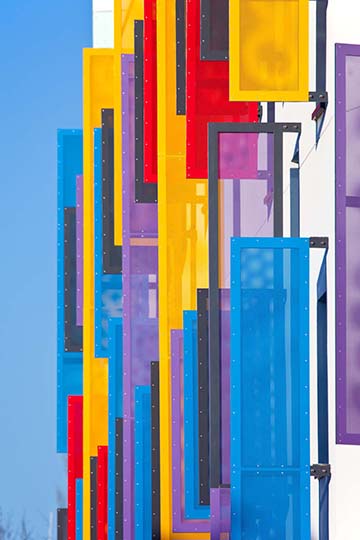Powder Coating
May 2019
 |
Over time all finishes exposed to weathering will be effected by the elements, this is especially relevant to buildings which are rarely cleaned on their exposed surfaces. On some materials, such as copper, the green patina effect once weathered can be very pleasing. More recently we have seen Corten exposed steel be used which weathers to a dark rusty hue. But when finishes that are intended to be bright colours on building completion fade over time, or possibly stain, this can be seen as a finish ‘failure’. So what about powder coating, how does it stand up against the elements?
The formulation of powder coated surface treatments has advanced over the forty years that powder coating was first specified for architectural metalwork. Many of the original projects are still in use today with the coating still doing its job protecting the aluminium or steel substrate. Much of the current architectural powder coating in the UK uses ‘Class 1’ powders which offer excellent adhesion and long life.
What is little known, is that powders themselves can be supplied in various grades of durability to suit a project application. These premium powder compositions use more expensive and robust materials to offer life expectancies well beyond 30 years and often similar to the life expectancy of the building itself. QUALICOAT has created quantifiable powder performance classifications for architectural powder coatings. In Europe there are three distinct classes of performance - Class 1, 2 & 3.
The key parameter to distinguish the performance of these Classes is their ‘weathering’ ability. That is to say, the ability to maintain a consistent colour and gloss level over time. To ‘weather’ well the coating must resist the deleterious effects of Light (in particular UVa & UVb), temperature and humidity. The globally accepted method for this ‘natural weathering’ test is conducted in Florida, USA. Sample panels are set for external exposure at a given angle 5° South. Powders are then classified on the following performances:
Class 1 powders
•
After 12 months less than 50% loss of gloss, and colour change between 2 and 6 delta units (subject to the colour).
•
This pass criterion is commonly known as ‘1 year Florida’.
Class 2 powders
•
After 12 months, less than 25% loss of gloss,
•
After 24 months, less than 33% loss of gloss.
• After 36 months, less than 50% loss of gloss.
•
After 3 years colour change 2 to 6 delta units, dependent on colour.
•
This testing criterion is commonly known as ‘3 year Florida’
Class 3 powders
•
After 10 years, up to 50% loss of gloss – or commonly known as ’10 year Florida’.
By specifying ‘QUALICOAT’, the method of pre-treatment and powder coat application of the powder classes is more tightly monitored and the chances of coatings failing due to corrosion or adhesion during its expected life are significantly reduced compared to coaters adopting non-controlled standards.
Whilst Class 1 is the standard powder used across the UK, Class 2 powders are growing in popularity with specifiers and offers a greater durability against weathering. It is important to state that whilst Class 1 will weather, as shown in its class above, that does not mean that the finish fails to perform. Class 1 powder finishes have a life expectancy of 30 years or more.
The Zurich based QUALICOAT Secretariat ensures this class quality label is applied consistently across the globe. Whether the contracts are specified in the UK, China, Germany or Australia, if QUALICOAT is part of the specification it will be understood and applied consistently.
The vast majority of high end powder coaters in the UK are now QUALICOAT approved and to ensure that specifiers get ‘QUALICOAT’ powder coating, the association recommends just adding the name ‘QUALICOAT Approved’ to the material specifications and the applicator of the architectural finish.
On new and refurbished buildings powder coated finishes will always come with a cleaning and maintenance regime from the company who coated the aluminium profiles. These will be minimal cleaning requirements and need to be adhered to as well as recorded when cleaning takes place. This will ensure the coated finish is maintained within the warranty wording and will help should there be any claim in the future. Warranties vary in time and are dependent of the powder coat finish used and the location of the installation. For example, where the coating is close to the sea, a marine grade or QUALICOAT ‘Seaside’ specification for the coating must be used and the cleaning regime interval reduced to three monthly intervals as the atmosphere is more corrosive.
QUALICOAT UK & Ireland offer a basic guide which can be downloaded from their website. This can be referred to as where the original maintenance information has been mislaid and not available to refer to.
www.qualicoatuki.org
|
